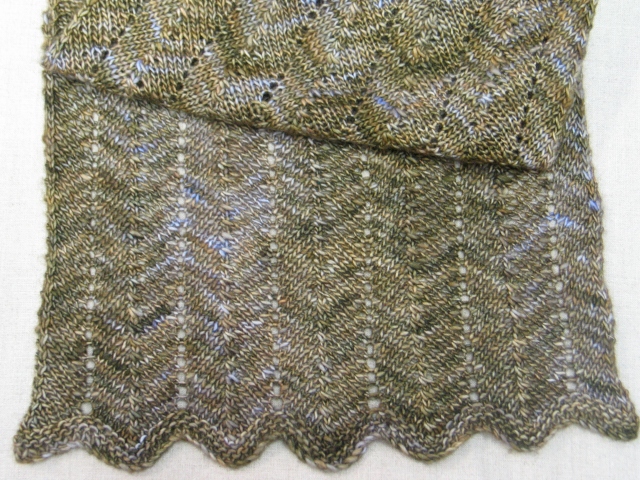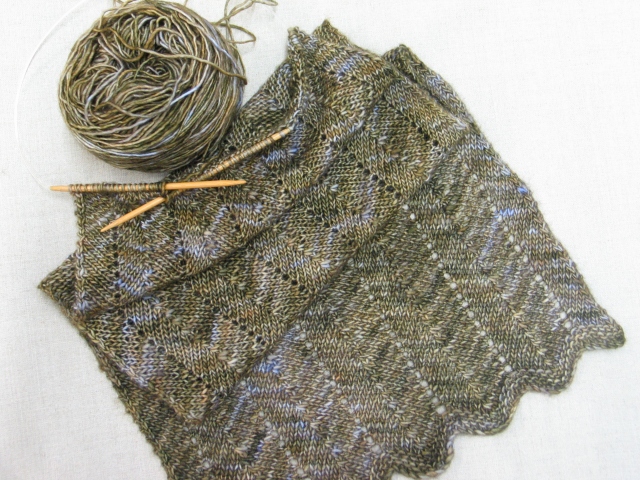Haley at Knitomatic and I have been friends for a very long time, since before she opened her store and I have to say, it is very convenient having a best friend who owns a yarn store. That is why you will see her store referenced many times throughout my blog.
On my last trip to her store, she graciously gifted me with a skein of Madeline Tosh Light in the colour Vanilla Bean. I guess, with our never-ending winter and its dark brown colour with subtle flashes of lilac throughout it just wasn’t as appealing as the bright yarns sitting next to it. I have 3 projects I am working on concurrently, and tons of projects in the queu (my Pinterest board DIY Knitting Patterns is basically my wish list) – but I had to start something with this yarn.
I love squishy, long scarves – long enough to wrap around several times and wide, too. The colour of the yarn reminds me of warm and heathered tweed. I knew I wanted the resulting fabric to have the same effect and when I came across this chevron pattern it was exactly what I had pictured in my head!
Skill Level
Many beginner knitters have been interested in the Versa Scarf pattern offered at the start of this blog and were inquiring about the skill level required. Your questions got me thinking about how to categorize skill level in general and where you might place your own skill level.
Knitting is comprised of the knit stitch and the purl stitch. That’s it – 2 stitches. Once you master those, you can make anything. That is what I find so interesting about knitting – it is binary code – we are human computers. By simply combining knit and purl stitches, there are endless possibilities!
So, you can knit and you can purl. Does that alone make you an expert? – No, not yet, anyhow. Author Malcolm Gladwell states, “In fact, researchers have settled on what they believe is the magic number for true expertise: ten thousand hours.” , Outliers: The Story of Success. That works out to about 5 years of constant practice.
Now with that amount of practice under your belt you have made many, many, many mistakes. Frogged lots of projects – started and re-started projects, abandoned projects, cursed and swore, and jumped up and down even. But, this is the basis for your expertise. It is the ability to recognize AND consequently FIX your mistakes – that determines your skill level.
If you can fix your mistakes in garter stitch and stockinette, then you are ready for intermediate patterns. If you can work a lace pattern and recognize when you have missed a yarn over and can fix the problem without frogging back to the previous row or, you can fix a dropped stitch when working in a pattern without ripping back to the problem area – without tearing your hair out – then you are ready for advanced patterns. Intermediate knitters should be able to recognize stitch combinations by sight when working a repeating pattern – applies to lace and cable pattern repeats.
I consider myself an expert or advanced knitter. As a conservative estimate, I have put in close to 30,000 hours, over 16 years. Does that mean I don’t make mistakes? Nope – I still make A LOT! The difference between a beginner and expert (in any field, I suppose)? The expert feels confident in their ability to fix their mistakes. Whew! That much thinking hurts my brain – time to knit!
Chevron Scarf
Madeline Tosh Merino Light: Vanilla Bean
100 % superwash Merino
384 m (284 yds)
3.75mm needles (5US)
Finished Measurements (approx): 30 cm x 184 cm (12″ x 72″)
Gauge: adjustable with yarn and needle size (cast on more or less stitches in multiples of 12)
Fingering weight – 26 – 30 sts per row = 10cm (4″) in Stockingette Stitch with 2.25 – 2.75mm needles
Chevron Pattern – 24sts and 28 rows = 10cm (4″)
Chevron Pattern (multiple of 12 + 3 stitches)
***Please note the stitch count varies on right side (RS) rows. Stitch count will be – 2 stitches less for every 12 stitch repeat. These 2 decreased stitches will be added on the wrong side (WS) row, returning the stitch count to the original cast on number***
RS: K1, skp, *k9, sl 2 sts purlwise, k1, p2 psso *, to last 12 sts, k9, k2tog, k1
WS: k1, *p5, (p1, yo, p1) in the next stitch, p4*, to last 2 sts, p1, k1
Glossary
sl 2 sts purlwise, k2, p2, psso = slip 2 stitches purlwise, one at a time, knit the next stitch, pass the 2 slipped stitches over the knit stitch (2 stitches decreased)
SCARF
Cast on 75 sts. Knit 4 rows.
Begin Chevron Pattern, work 2 row repeat until desired length.
Knit 4 rows.
Cast off knitwise.
Weave in ends and block, stretching width wise to open up stitch pattern.
Enjoy the pattern!



Your stitch description in the glossary says you are slipping 2 stitches purlwise, k2, p2, psso. You describe it as a double decrease – two stitches decreased. If you slip 2 and then k2, p2, psso, you would be decreasing 5 stitches?
I apologize for the late response, as you can see I haven’t been using the blog. But, the decrease = 2 stitches, not 5. Some things are difficult to make sense of when you read through the pattern, but in practice it will work out. Try it!